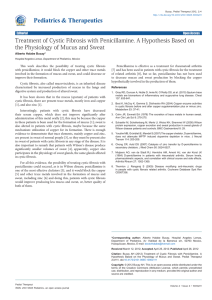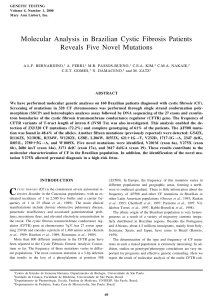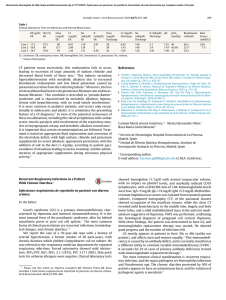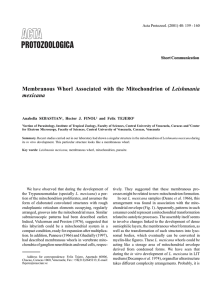The expression of the mitochondrial encoded
Anuncio
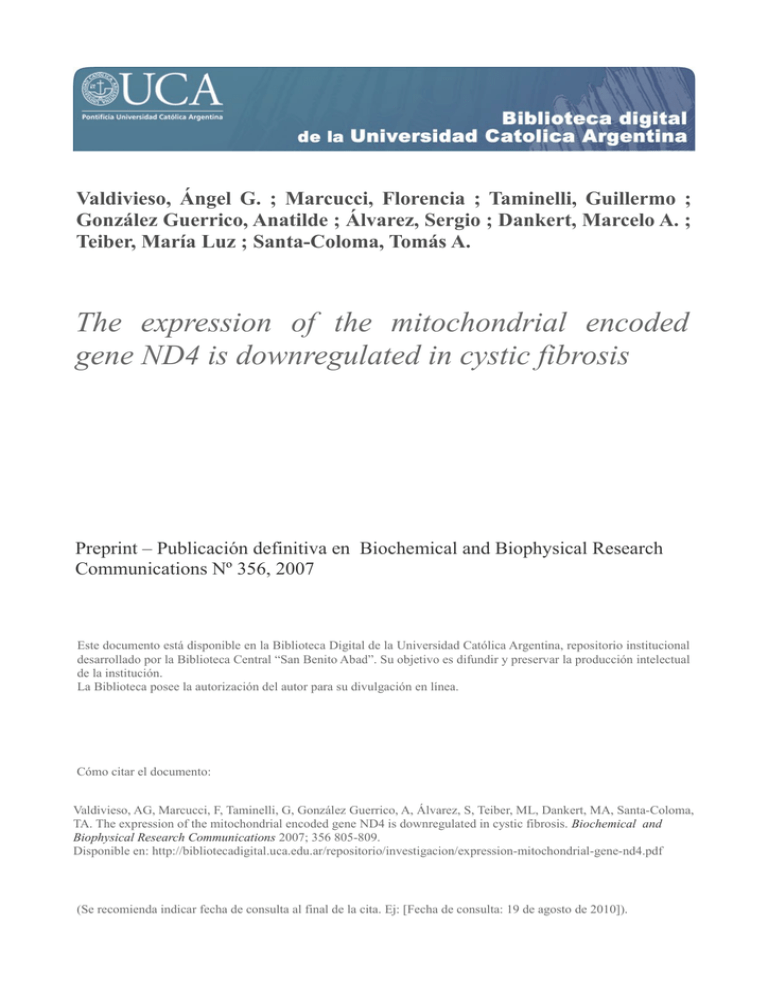
Valdivieso, Ángel G. ; Marcucci, Florencia ; Taminelli, Guillermo ; González Guerrico, Anatilde ; Álvarez, Sergio ; Dankert, Marcelo A. ; Teiber, María Luz ; Santa-Coloma, Tomás A. The expression of the mitochondrial encoded gene ND4 is downregulated in cystic fibrosis Preprint – Publicación definitiva en Biochemical and Biophysical Research Communications Nº 356, 2007 Este documento está disponible en la Biblioteca Digital de la Universidad Católica Argentina, repositorio institucional desarrollado por la Biblioteca Central “San Benito Abad”. Su objetivo es difundir y preservar la producción intelectual de la institución. La Biblioteca posee la autorización del autor para su divulgación en línea. Cómo citar el documento: Valdivieso, AG, Marcucci, F, Taminelli, G, González Guerrico, A, Álvarez, S, Teiber, ML, Dankert, MA, Santa-Coloma, TA. The expression of the mitochondrial encoded gene ND4 is downregulated in cystic fibrosis. Biochemical and Biophysical Research Communications 2007; 356 805-809. Disponible en: http://bibliotecadigital.uca.edu.ar/repositorio/investigacion/expression-mitochondrial-gene-nd4.pdf (Se recomienda indicar fecha de consulta al final de la cita. Ej: [Fecha de consulta: 19 de agosto de 2010]). THE EXPRESSION OF THE MITOCHONDRIAL ENCODED GENE ND4 IS DOWNREGULATED IN CYSTIC FIBROSIS Ángel G. Valdivieso#, Florencia Marcucci#, Guillermo Taminelli, Anatilde González Guerrico, Sergio Álvarez, Marcelo A. Dankert, María Luz Teiber and Tomás A. Santa-Coloma* Facultad de Ciencias Exactas y Naturales, Universidad de Buenos Aires (FCEyN, UBA); Instituto de Investigaciones Bioquímicas (IIB) de Buenos Aires, Consejo Nacional de Investigaciones Científicas y Técnicas (IIBBA, CONICET), IIB Fundación Campomar (now Fundación Instituto Leloir); and Facultad de Ciencias Médicas, Programa de Investigaciones Biomédicas, Pontificia Universidad Católica Argentina. Buenos Aires, Argentina. Running title: CFTR regulates ND4 expression. # These authors contributed equally to this work. tasc@iib.uba.ar Address correspondence to: Tomás A. Santa Coloma, Laboratorio de Biología Celular y Molecular, Patricias Argentinas 435, 1405 Buenos Aires, Argentina. Tel/Fax. (54-11) 5238-7500, ext. 2307; e-mail: tsantacoloma@gmail.com 1 ABSTRACT Cystic fibrosis (CF) is a disease produced by mutations in the CFTR channel. We have previously reported that the CFTR chloride transport activity regulates the differential expression of several genes, including SRC. Here we report that MT-ND4, a mitochondrial gene encoding a subunit of the mitochondrial Complex I (mtCx-I), is also a CFTR-dependent gene. A reduced expression of MT-ND4 was observed in CFDE cells (derived from a CF patient) when compared to CFDE cells ectopically expressing wild type CFTR. The differential expression of MT-ND4 in CF was confirmed by PCR. In situ hybridizations of deparaffinized human lung tissue slices derived from wt-CFTR or CF patients also showed downregulation of ND4 in CF. In addition, glibenclamide or CFTR(inh)-172 (CFTR chloride transport inhibitors) reduced MT-ND4 expression in cells expressing wt CFTR. These results suggest that the CFTR chloride transport activity indirectly up-regulates MT-ND4 expression. Keywords: Cystic Fibrosis, CFTR, MT-ND4, CFDE, mitochondria, mitochondrial expressed genes, glibenclamide, CFTR(inh)-172. 2 INTRODUCTION Cystic fibrosis is the most common and lethal autosomic recessive disease among Caucasians [1, 2]. Mutations on the CFTR gene [1, 3, 4], which encodes for a chloride transport channel of the ABC type [1, 5], are responsible for the disease. After the CFTR was cloned [1], an important goal was to understand in which way its chloride transport activity might be responsible for the CF phenotype. One hypothesis followed by several laboratories was the idea that the CFTR might, in some way, indirectly regulate the expression of a net of specific genes, which eventually would provide the CF phenotype. In this regard, using differential display [6], we have found in the past several differentially expressed genes in CF, and characterized one as SRC, which encodes for the protein-tyrosine kinase c-Src [7]. As a model system we used cultured tracheobronchial gland epithelial cells, derived from a cystic fibrosis patient (CFDE cells) [8], and the same cells ectopically expressing wild type CFTR (CFDE/6RepCFTR cells). In the present work, we have characterized another CFTR-dependent gene: MTND4. This is a mitochondrial gene that encodes for the subunit 4 of NADH-ubiquinone oxidoreductase (Complex I), a component of the electron transport chain [9]. The MTND4 mRNA was decreased in CFDE cells and CF lung tissues. The CFTR transport inhibitor glibenclamide, or the recently developed CFTR(inh)-172, induced downregulation of ND4 expression in CFDE/6RepCFTR cells. These results are interesting, since MT-ND4 is a key component for the activity of the mitochondrial Complex I (mtCx-I). 3 MATERIALS AND METHODS Cell lines: CFDE are tracheobronquial gland epithelial cells obtained from a CF patient [8], and transformed with linearized pSVori- [10], a plasmid containing a replicationdeficient simian virus 40 (SV 40) genome. The CFDE cells, assayed by Cl- efflux, 6methoxy-N- (3-sulfopropyl) quinolinium (SPQ, a chloride-sensitive dye), and patch clamp, are defective in cAMP-dependent chloride transport that is characteristic of CFTR [8]. CFDE/6RepCFTR cells are CFDE cells in which an episomal expression of wildtype (wt) CFTR corrects the defective cAMP-dependent chloride transport. Both cells lines were generously provided by Dr. Dieter Gruenert (UCSF), and its were cultured as previous described [8]. Briefly, the cells were grown on plastic over a coating of bovine fibronectin and collagen Type I, and using a DMEM-F12 1:1 (Life Technologies, GIBCO BRL, Rockville, MD) mixture supplemented with 10 units/ml penicillin, 10 µg/ml streptomycin (Life Technologies, Rockville, MD) and 10% fetal bovine serum (BIOSER, Buenos Aires, Argentina). Transfected CFDE/6RepCFTR cells were grown in the presence of hygromycin B (100 µg/ml, Sigma-Aldrich, St. Louis, MO). All cells were cultured in a water-saturated atmosphere of 95% air and 5% CO2. Inhibition of the CFTR chloride transport activity: CFDE and CFDE/6RepCFTR cells were cultured to 70-80% confluence in 78 cm2 tissue culture dishes for each treatment. After growth, the medium was removed, and serum-free medium was added to the cells. After a 24-hs incubation at 37 °C, different concentration of inhibitors (glibenclamide 50, 100, and 150 µM; CFTR(inh)-172 2.5, 5, and 10 µM) were added to the serum-free 4 medium and incubated for additional 24-hs at 37 °C. Total RNA was extracted by using TRI Reagent (Sigma-Aldrich) and analyzed by semiquantitative PCR. The mRNA was precipitated from 50% isopropanol, resuspended in sterile DEPC-treated water and, if necessary, stored at –70oC until use. The ratios at A260/A230 (greater than 2.0) and A260/A280 (from 1.7 to 2.0) were determined to verify RNA purity. Differential Display, Cloning and Sequencing: Differential display (DD), of mRNA was carried out as described by Liang and Pardee [6, 11] with modifications that allowed us to avoid false positive results [7, 12]. Briefly, total RNA was isolated as described above from CFDE cells, CFDE/6RepCFTR cells and CFDE/6RepCFTR cells treated with the Cl- transport inhibitor glibenclamide (50 µM, 24 h). To perform the PCR, 200 ng of total RNA were used for each sample. The primers used for the PCR reaction were 20 random primers (used separately) of 10 mer (RAPID primers from Operon Technologies, Alameda, CA) and 5’-T12(ACG)A-3’. Cloning and sequencing was performed as previously described [7, 12]. Semiquantitative Reverse Transcription-PCR (RT-PCR): This method was used to validate the DD results and to determine the effects of different doses of CFTR inhibitors. Total RNA samples (4 µg) derived from CFDE, CFDE/6RepCFTR and CFDE/6RepCFTR cells treated with different concentrations of glibenclamide or CFTR(inh)-172 were incubated in the presence RQ1 RNase-Free DNase I (1 U/µg total RNA; Promega, Madison, WI). Reverse transcription was made by using M-MLV Reverse Transcriptase (Promega) according to the manufacturer’s instructions, with few 5 modifications. Briefly, Reverse transcription was performed using 1 µg DNA-free RNA, reverse primers specific for ND4 (5´-GACTGTGAGTGCGTTCGTA-3´) and GAPDH (5´-TGTGGTCATGAGTCCTTCCA-3´) and 100 U of RT/µg of RNA. Semiquantative RT-PCR was carried out employing GAPDH as an internal control. The cDNA samples (different dilutions) were added to 40 µl of PCR reaction mixture containing buffer (final concentration 1.5 mM MgCl2, 0.4 mM deoxynucleotides triphosphates, 1 unit of Taq DNA polymerase (Promega), and the same reverse primers used in the reverse transcription and the following forward primers: 5´-CTCACAACACCCTAGGCTCA-3´ for ND4 and 5´-CCCATCACCATCTTCCAGGA-3´ for GAPDH. Preliminary experiments with different cDNA dilutions were performed in order to determine the exponential phase of the PCR amplification. PCR conditions were: denaturation at 94oC 4 min, and 30 cycles of 94 oC (30 s), 50 oC(40 s), and 72 oC (60 s). After the completion of PCR, 10 µl of each PCR mix were separated in 3% agarosa gels containing ethidium bromide and visualized whit the use of UV transilluminator (UVP, Inc. Upland, CA, U.S.A.) and recorded. The signal intensities of the PCR products were calculated by using the NIH image software (Scion Corp., Frederick, MD). Better results were obtained by measuring the ND4 and the GAPDH levels in different tubes instead of multiplex (same tube). Samples from at least two independent experiments were used for ANOVA and Tukey analysis. In situ hybridization for MT-ND4 mRNA: In situ hybridizations (ISH) were performed to determine MT-ND4 mRNA levels in control and CF human lung slices (5 µm slices corresponding to five different samples obtained from pathological archives). The 6 sections were deparaffinized with xylene and rehydrated with a gradient alcohol-H2O before use. Microwave pretreatment was performed to enhance the ISH signal [13]. Nonspecific binding sites were blocked with PBS containing 5% bovine serum albumin, for 1 h. The slices were then incubated for 18 h at 600 C with a hybridization solution containing 0.05 µg probe, 100 µg ssDNA (heat denatured DNA from fish sperm, stock 10 mg/ml in DEPC water) and 50 µg tRNA (from yeast, stock 10 mg/ml in DEPC water) in a final volume of 100 µl. The probe used to detect the MT-ND4 mRNA, 5’BiotGGTAATGATGTCGGGGTTGAGGGATAGGAGGAGAATGGGGGATAGGTGT ATGAACATGAG-3’, was designed by using the GCG program (www.gcg.com, Accelerys, Madison, WI) and synthesized in an OLIGO1000M Beckman synthesizer. After the incubation, the slices were rinsed twice with SSC buffer, incubated with alkaline-phosphatase-streptavidin in BSA 1% (dilution 1/2500) and washed again with SSC, twice. The color was developed adding NBT/BCIP as indicated by the manufacturer (Promega) and captured by using a confocal Zeiss LSM510 microscope under transmitted light detection. Statistical Analysis: The figures are representative of at least two independent experiments. Each independent experiment was performed by using duplicates. To determine significant differences (p< 0.05), one-way ANOVA was performed applying the Tukey test for post-hoc comparisons. 7 RESULTS Differential Display (DD) of CFDE and CFDE/6RepCFTR cells: The results corresponding to the primer OPA-3: 5′-AGTCAGCCAC-3′ are shown in the Figure 1. Several differentially expressed mRNAs were detected in CFDE and CFDE/6RepCFTR cells. As expected for a gene which expression depends of CFTR chloride transport activity, the DD pattern of some mRNAs reverted in the CFDE/6RepCFTR treated with glibenclamide, and become similar to the pattern found in CFDE cells. One spot corresponding to a differentially expressed gene product was selected for further characterization (indicated with an arrow in Figure 1A). It was particularly interesting to us since it behaved contrary to the differentially expressed SRC (c-src is upregulated in CFDE cells and can be also modulated by CFTR inhibitors) [7]. The corresponding cDNA fragment was isolated from the DD gel, PCR-amplified, purified by agarose gel electrophoresis, cloned and sequenced. The sequence of the cloned PCR fragment (Fig. 1 B) was identical to the sequence encoding the human mitochondrial subunit 4 (MT-ND4). Differential Display Validation: In order to validate the differential expression of ND4 semiquantative reverse transcriptase-PCR, as shown in Figure 2. The results confirmed the differential expression of MT-ND4 and its down-regulation in CFDE cells and CFDE/6RepCFTR cells treated with glibenclamide. This inhibitor was able to revert the effects of the ectopic expression of wt-CFTR in CFDE/6RepCFTR cells, suggesting that the differential expression is indeed due to the activity of the CFTR chloride transport 8 channel and not only the presence of the CFTR at the cell membrane, as occurs with the cytokine RANTES [14]. In situ Hybridization of MT-ND4 mRNA in human CF and normal lungs: To determine whether the down-regulation of MT-ND4 observed in CFDE cells was actually reflected in the CF human airway, the expression of MT-ND4 mRNA was studied by in situ hybridization using human lung tissues slices from pathological archives. As shown in Figure 3, the down-regulation of MT-ND4 mRNA was also observed in human lung slices derived from CF patients (four additional samples derived from different CF patients were studied with similar results, not shown), suggesting that MT-ND4 mRNA is not only down-modulated in cultured CFDE cells but also in CF patients. Although slices from the same samples showed opposite results for SRC [7], the results should be taken with caution, since these lungs tissue slices has been taken from lung transplanted patients that were previously exposed to bacterial infections and antibiotic treatments during several years before the samples were obtained and could be a response to inflammation or other processes, and not due to a direct CFTR effect . Effects of CFTR(inh)-172 over ND4 expression: While this work was in progress, a new CFTR inhibitor was developed, claimed to be more potent and specific than glibenclamide. Therefore, its effect was tested by using reverse-transcription followed by semiquantitative PCR of mRNA extracted of CFDE and CFDE/6RepCFTR cells treated with different doses of inhibitors. The results shown in the Figure 4 are in agreement with the DD results of Figure 1 and confirm that MT-ND4 is down-modulated in CFDE cells, 9 that the inhibition of the chloride transport activity of CFTR results in MT-ND4 downregulation, and that this effect can be achieved either by using glibenclamide or CFTR(inh)-172. Also, it was observed that the CFTR(inh)-172 is more potent than gliblenclamide, with a clear inhibitory effect over ND4 expression between 2,5-10 µM. In our conditions, the low water solubility of CFTR(inh)-172 precludes concentrations beyond 10 µM. Thus, at least when the expression of MT-ND4 in CFDE cell cultures is considered, CFTR(inh)-172 (ED50 = 1.7 + 0.6 µM) is almost 100 times more potent than glibenclamide (ED50 > 150 µM + SD). DISCUSSION The characterization of CFTR-dependent genes might open the way to a better understanding of the CF phenotype and to define new possible targets for therapy. Here we have characterized a new CFTR-dependent gene differentially expressed in CFDE cells. It was identified as MT-ND4, a mitochondrial gene encoding the subunit 4 of the mitochondrial NADH-ubiquinone oxidoreductase complex or mitochondrial Complex I (mtCx-I). Contrary to c-Src [7], MT-ND4 was downregulated in CF cultured cells and CF human lung tissue. The increased expression of MT-ND4 mRNA seen in CFDE/6RepCFTR cells (cells expressing wt CFTR) was reversed by incubation with the CFTR channel inhibitors glibenclamide or CFTR(inh)-172, suggesting a causal relationship between the CFTR chloride transport activity and the MT-ND4 expression. The down-regulation of MT-ND4 observed in the DDs was confirmed by using semi quantitative RT-PCR and in situ hybridizations (ISH) of lung tissues from non-CF subjects and CF patients. Taken together, these results suggest that MT-ND4 expression 10 is reduced in CF, and that this effect should arise as a consequence of the impairment of chloride transport activity of CFTR in CF, since a similar downregulation of MT-ND4 expression can be obtained by using CFTR inhibitor in CF corrected cells. MT-ND4 is a key component for the activity of Complex I [15, 16]. Though MT-ND4 is not directly responsible of any of the catalytic activities associated with the Complex I, it would be involved in the conformation of the active site and, together with ND5, would be essential for the activity [17]. The down-modulation of the MT-ND4 mRNA observed in CF cells and tissues might in turn induce a failure in the activity of the mitochondrial Complex I, since MTND4 is essential for the assembly and activity of this complex [15-19]. This is in agreement with earlier reports on epithelial fibroblasts isolated from CF patients, in which changes in the pH optima and Km of Complex I has been reported [20-22]. On the other hand, it has been shown recently that a severe impairment of nucleotide synthesis occurs through inhibition of mitochondrial respiration [23], thus a reduced activity of the mitochondrial Complex I might also induce a reduced ATP synthesis. In fact, a reduced ATP synthesis was found during physical exercise in the skeletal muscle of CF patients [24], together with a reduction in the oxidative efficiency of the skeletal muscle, which provokes exercise intolerance attributed to failures of the Complex I activity [25]. Our results and the earlier observations regarding altered mitochondrial activity in CF cells, suggest that the mitochondria might have an important role in defining the cystic fibrosis phenotype, under the influence of the CFTR chloride transport activity. MT-ND4 was downregulated by CFTR inhibitors. However, the mechanism by which this and similar CFTR-dependent genes are regulated is largely unknown. In some 11 way the open state of the CFTR channel or the activation of the chloride transport is transduced inside the cell. On the other hand, there are CFTR-dependent genes that cannot be modulated by CFTR chloride transport inhibitors, as occurs with the chemokine RANTES [14]. Interestingly, this CFTR-dependent gene is modulated by the C-terminal PDZ-interacting motif of CFTR, independently of the CFTR chloride transport activity [14]. In consequence, there are two types of CFTR-dependent genes: those depending on direct interactions of the CFTR molecule at the cell membrane with other transducers independently of the transport activity, as occurs with RANTES, and those depending specifically on its chloride transport activity, as it is the case for c-Src (MUC1 through c-Src) and ND4. Perhaps the most intriguing issue right now is to determine in which way the chloride transport activity might be transduced into gene regulation. The mechanism might be very indirect, through changes in the membrane potential that affects other signaling channels or proteins; although it might be also a direct mechanism, thought interactions of CFTR with other molecules after some conformational state reached when the CFTR channel is open. In addition, some CFTRdependent genes might be under the regulation of purinergic receptors, activated by the ATP, ADP and AMP released to the airway surface liquid (ASL) in the presence of functional CFTR, through a yet unknown transporter [26-28]. Further studies are needed to understand how MT-ND4 is modulated by CFTR, how this modulation affects mitochondrial functions, and to which extend the reduced expression of ND4 might contribute to the CF phenotype. 12 ACKNOWLEDGEMENTS Paraffinated human lung slices from pathological archives were generously provided by Dr. Guillermo Gallo, from the “Hospital de Pediatría Prof. Dr. Juan P. Garrahan” and by Dr. Sergio V. Perrone, from the “Fundación Favaloro”, Buenos Aires, Argentina. The CFDE and CFDE/6RepCFTR cells were a gift from Dieter Gruenert (California Pacific Medical Center Research Institute, San Francisco, CA, USA). This work was supported by grants from the University of Buenos Aires (www.uba.ar, TW67, X-138 and X-156), the National Research Council of Argentina (www.conicet.org.ar, PIP694/98), the National Agency for the Promotion of Science and Technology (ANPCYT, www.anpcyt.gov.ar, PICT 05-13970) and the Ministry of Health of Argentina (Fellowship Carrillo-Oñativia, 2003-2004) to TASC. REFERENCES [1] J.R. Riordan, J.M. Rommens, B. Kerem, N. Alon, R. Rozmahel, Z. Grzelczak, J. Zielenski, S. Lok, N. Plavsic, J.L. Chou, M.L. Drum, M.C. Iannuzzi, F. Collins, L.-C. Tsui, Identification of the cystic fibrosis gene: cloning and characterization of complementary DNA, Science 245 (1989) 1066-1073. [2] F.S. Collins, Cystic fibrosis: molecular biology and therapeutic implications, Science 256 (1992) 774-779. [3] J.M. Rommens, M.C. Iannuzzi, B. Kerem, M.L. Drumm, G. Melmer, M. Dean, R. Rozmahel, J.L. Cole, D. Kennedy, N. Hidaka, et al., Identification of the cystic fibrosis gene: chromosome walking and jumping, Science 245 (1989) 1059-1065. 13 [4] B. Kerem, J.M. Rommens, J.A. Buchanan, D. Markiewicz, T.K. Cox, A. Chakravarti, M. Buchwald, L.C. Tsui, Identification of the cystic fibrosis gene: genetic analysis, Science 245 (1989) 1073-1080. [5] C.E. Bear, F. Duguay, A.L. Naismith, N. Kartner, J.W. Hanrahan, J.R. Riordan, Clchannel activity in Xenopus oocytes expressing the cystic fibrosis gene, J Biol Chem 266 (1991) 19142-19145. [6] P. Liang, A.B. Pardee, Differential display of eukaryotic messenger RNA by means of the polymerase chain reaction [see comments], Science 257 (1992) 967-971. [7] A.M. Gonzalez-Guerrico, E.G. Cafferata, M. Radrizzani, F. Marcucci, D. Gruenert, O.H. Pivetta, R.R. Favaloro, R. Laguens, S.V. Perrone, G.C. Gallo, T.A. Santa-Coloma, Tyrosine kinase c-Src constitutes a bridge between cystic fibrosis transmembrane regulator channel failure and MUC1 overexpression in cystic fibrosis, J Biol Chem 277 (2002) 17239-17247. [8] D.C. Lei, K. Kunzelmann, T. Koslowsky, M.J. Yezzi, L.C. Escobar, Z. Xu, A.R. Ellison, J.M. Rommens, L.C. Tsui, M. Tykocinski, D.C. Gruenert, Episomal expression of wild-type CFTR corrects cAMP-dependent chloride transport in respiratory epithelial cells, Gene Ther 3 (1996) 427-436. [9] J. Hirst, J. Carroll, I.M. Fearnley, R.J. Shannon, J.E. Walker, The nuclear encoded subunits of complex I from bovine heart mitochondria, Biochim Biophys Acta 1604 (2003) 135-150. [10] A.L. Cozens, M.J. Yezzi, L. Chin, E.M. Simon, W.E. Finkbeiner, J.A. Wagner, D.C. Gruenert, Characterization of immortal cystic fibrosis tracheobronchial gland epithelial cells, Proc Natl Acad Sci U S A 89 (1992) 5171-5175. 14 [11] P. Liang, L. Averboukh, A.B. Pardee, Distribution and cloning of eukaryotic mRNAs by means of differential display: refinements and optimization, Nucleic Acids Res 21 (1993) 3269-3275. [12] E.G. Cafferata, A.M. Gonzalez-Guerrico, O.H. Pivetta, T.A. Santa-Coloma, Identification by differential display of a mRNA specifically induced by 12-Otetradecanoylphorbol-13-acetate (TPA) in T84 human colon carcinoma cells, Cell Mol Biol (Noisy-le-grand) 42 (1996) 797-804. [13] V. Mitchell, K. Feyereisen, S. Bouret, D. Leroy, J.C. Beauvillain, Microwave strategy for improving the simultaneous detection of estrogen receptor and galanin receptor mRNA in the rat hypothalamus, J Histochem Cytochem 49 (2001) 901-910. [14] K. Estell, G. Braunstein, T. Tucker, K. Varga, J.F. Collawn, L.M. Schwiebert, Plasma membrane CFTR regulates RANTES expression via its C-terminal PDZinteracting motif, Mol Cell Biol 23 (2003) 594-606. [15] G. Hofhaus, G. Attardi, Lack of assembly of mitochondrial DNA-encoded subunits of respiratory NADH dehydrogenase and loss of enzyme activity in a human cell mutant lacking the mitochondrial ND4 gene product, Embo J 12 (1993) 3043-3048. [16] M. Degli Esposti, V. Carelli, A. Ghelli, M. Ratta, M. Crimi, S. Sangiorgi, P. Montagna, G. Lenaz, E. Lugaresi, P. Cortelli, Functional alterations of the mitochondrially encoded ND4 subunit associated with Leber's hereditary optic neuropathy, FEBS Lett 352 (1994) 375-379. [17] A. Chomyn, Mitochondrial genetic control of assembly and function of complex I in mammalian cells, J Bioenerg Biomembr 33 (2001) 251-257. 15 [18] A. Majander, K. Huoponen, M.L. Savontaus, E. Nikoskelainen, M. Wikstrom, Electron transfer properties of NADH:ubiquinone reductase in the ND1/3460 and the ND4/11778 mutations of the Leber hereditary optic neuroretinopathy (LHON), FEBS Lett 292 (1991) 289-292. [19] Y. Bai, P. Hajek, A. Chomyn, E. Chan, B.B. Seo, A. Matsuno-Yagi, T. Yagi, G. Attardi, Lack of complex I activity in human cells carrying a mutation in MtDNAencoded ND4 subunit is corrected by the Saccharomyces cerevisiae NADH-quinone oxidoreductase (NDI1) gene, J Biol Chem 276 (2001) 38808-38813. [20] B.L. Shapiro, R.J. Feigal, L.F. Lam, Mitrochondrial NADH dehydrogenase in cystic fibrosis, Proc Natl Acad Sci U S A 76 (1979) 2979-2983. [21] B.L. Shapiro, L.F. Lam, R.J. Feigal, Mitochondrial NADH dehydrogenase in cystic fibrosis: enzyme kinetics in cultured fibroblasts, Am J Hum Genet 34 (1982) 846-852. [22] M.C. Dechecchi, E. Girella, G. Cabrini, G. Berton, The Km of NADH dehydrogenase is decreased in mitochondria of cystic fibrosis cells, Enzyme 40 (1988) 45-50. [23] N. Gattermann, M. Dadak, G. Hofhaus, M. Wulfert, M. Berneburg, M.L. Loeffler, H.A. Simmonds, Severe impairment of nucleotide synthesis through inhibition of mitochondrial respiration, Nucleosides Nucleotides Nucleic Acids 23 (2004) 1275-1279. [24] K. de Meer, J.A. Jeneson, V.A. Gulmans, J. van der Laag, R. Berger, Efficiency of oxidative work performance of skeletal muscle in patients with cystic fibrosis, Thorax 50 (1995) 980-983. [25] S. DiMauro, Exercise intolerance and the mitochondrial respiratory chain, Ital J Neurol Sci 20 (1999) 387-393. 16 [26] G.M. Braunstein, A. Zsembery, T.A. Tucker, E.M. Schwiebert, Purinergic signaling underlies CFTR control of human airway epithelial cell volume, J Cyst Fibros 3 (2004) 99-117. [27] C.H. Mitchell, D.A. Carre, A.M. McGlinn, R.A. Stone, M.M. Civan, A release mechanism for stored ATP in ocular ciliary epithelial cells, Proc Natl Acad Sci U S A 95 (1998) 7174-7178. [28] E.R. Lazarowski, R. Tarran, B.R. Grubb, C.A. Van Heusden, S. Okada, R.C. Boucher, Nucleotide release provides a mechanism for airway surface liquid homeostasis, J Biol Chem (2004). 17 LEGENDS TO FIGURES Figure 1: Differential display (DD) of CFDE and CFDE/6RepCFTR airway epithelial cells. A: DD of CFDE cells (derived from a cystic fibrosis patient) and CFDE/6RepCFTR cells (CFDE cells ectopically expressing wt CFTR). The line Glibenclamide corresponds to CFDE/6RepCFTR cells treated with the Cl- channel inhibitor glibenclamide (50 µM, 24 h). B: Sequence corresponding to the cDNA fragment indicated with an arrow in A. It was obtained after PCR amplification, cloning, and sequencing of the spot indicated by an arrow in A. The isolated cDNA fragment had 100% identity with the mRNA of MT-ND4. Figure 2: Differential display validation. A: Reverse transcriptase followed by semiquantitative PCR. Total RNA was extracted from CFDE, CFDE/6RepCFTR treated or not with glibenclamide (100 µM). B: quantification of relative mRNA levels (ND4/GAPDH). The results are in agreement with the differential display results shown in Fig.1 and suggest a differential expression of MT-ND4 that can be reverted by treatment with the CFTR chloride channel inhibitor glibenclamide. * indicate p< 0.05 by applying ANOVA and Tukey tests. Figure 3: In Situ Hybridization in lung tissue. A: After cloning, the cDNA insert was used as probe for MT-ND4. It was labeled with biotin and revealed with alkaline phosphatase- streptavidin. A and B: human lung tissue from lung tissue slices expressing wt-CFTR. C and D: slices from a CF patient. B and D: samples incubated without probe, as controls. The same assay was repeated with tissues from additional four CF patients 18 and similar results were obtained. The results suggest that the down-modulation of MTND4 can be also observed in lung tissues derived from CF patients, and not only in CFDE cells. Figure 4: Effects of the CFTR inhibitor CFTR(inh)-172 on MT-ND4 expression. The effects of glibenclamide and CFTR(inh)-172 were compared. Both inhibitors show a dose-dependent inhibition of ND4 expression, although CFTR(inh)-172 is ≅ 100 times more potent (ED50 = 1.7 + 0.6 µM) than glibenclamide (ED50 > 150 µM ). * indicate p< 0.05 by applying ANOVA and Tukey tests. 19 FIGURE 1 20 FIGURE 2 21 FIGURE 3 22 * 0,4 0,2 0,0 * * Inh 10 * Inh 5 0,8 Inh 2.5 Glib 150 Glib 100 Glib 50 CFDE Control ND4/GAPDH expression 1,2 1,0 * * 0,6 FIGURE 4 23
